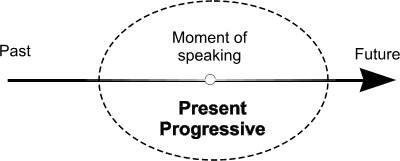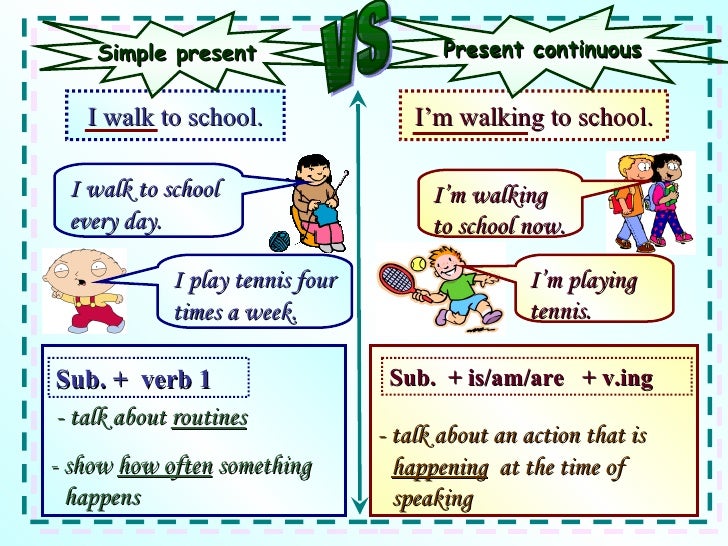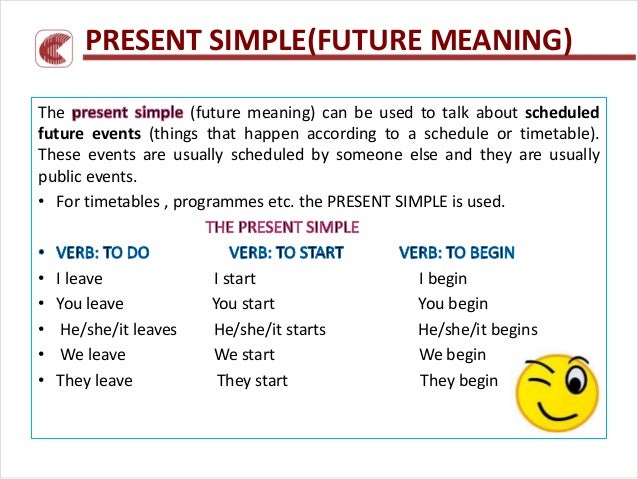martes, 13 de diciembre de 2016
martes, 22 de noviembre de 2016
PRESENT PROGRESSIVE OR CONTINUOUS
The present progressive puts emphasis on the course or duration of an action.

The present progressive is used for actions going on in the moment of speaking and for actions taking place only for a short period of time. It is also used to express development and actions that are arranged for the near future.
Present progressive is also known as present continuous.
Use a form of to be and the infinite verb plus -ing.
Use:
- am with the personal pronoun I
- is with the personal pronouns he, she or it (or the singular form of nouns)
- are with the personal pronouns you, we, they (or the plural form of nouns)
affirmative negative question
I am playing. I am not playing. Am I playing?
He is playing. He is not playing. Is he playing?
You are playing. You are not playing. Are you playing?
In negative sentences, we put not between the form of be and the verb.
In questions, we simply swop the places of subject and the form of be.
martes, 15 de noviembre de 2016
jueves, 10 de noviembre de 2016
miércoles, 5 de octubre de 2016
SIMPLE PRESENT FOR FUTURE EVENTS
The present simple can be used to talk about talk about scheduled future events.
These are events that happen according to a schedule or timetable. They are usually scheduled by someone else and they are usually public events.
Tomorrow is Friday.
I fly to Paris next week.
The plane departs at 8 p.m.
The train to Ottawa leaves at 11:30 a.m.
When do you leave for NYC?
Her train arrives at 8:35 a.m. tomorrow morning.
What time does the movie start tonight?
What time do you finish work tomorrow?
What time does the store open tomorrow?
Final exams start next week.
The concert begins at 6:30 p.m.
The Monet exhibit closes on Sunday.
The sale ends next week.
Tomorrow is Friday.
I fly to Paris next week.
The plane departs at 8 p.m.
The train to Ottawa leaves at 11:30 a.m.
When do you leave for NYC?
Her train arrives at 8:35 a.m. tomorrow morning.
What time does the movie start tonight?
What time do you finish work tomorrow?
What time does the store open tomorrow?
Final exams start next week.
The concert begins at 6:30 p.m.
The Monet exhibit closes on Sunday.
The sale ends next week.
IMPORTANT: Only the verbs below can be used in the simple present to talk about a future scheduled event:
arrive
be
begin
close
depart
end
finish
fly
leave
open
start
martes, 20 de septiembre de 2016
SIMPLE PRESENT TENSE
THE SIMPLE PRESENT TENSE IS USED:
To express habits, general truths, repeated actions or unchanging situations, emotions and wishes:
I smoke (habit); I work in London (unchanging situation); London is a large city (general truth)
To give instructions or directions:
You walk for two hundred meters, then you turn left.
To express fixed arrangements, present or future:
Your exam starts at 09.00
Be careful! The simple present is not used to express actions happening now.
EXAMPLES
For habits
He drinks tea at breakfast.
She only eats fish.
They watch television regularly.
EXAMPLES
For habits
He drinks tea at breakfast.
She only eats fish.
They watch television regularly.
For repeated actions or events
We catch the bus every morning.
It rains every afternoon in the hot season.
They drive to Monaco every summer.
For general truths
Water freezes at zero degrees.
The Earth revolves around the Sun.
Her mother is Peruvian.
For instructions or directions
Open the packet and pour the contents into hot water.
You take the No.6 bus to Watney and then the No.10 to Bedford.
Water freezes at zero degrees.
The Earth revolves around the Sun.
Her mother is Peruvian.
For instructions or directions
Open the packet and pour the contents into hot water.
You take the No.6 bus to Watney and then the No.10 to Bedford.
For fixed arrangements
His mother arrives tomorrow.
Our holiday starts on the 26th March
His mother arrives tomorrow.
Our holiday starts on the 26th March
FORMING THE SIMPLE PRESENT TENSE: TO THINK
Affirmative Interrogative Negative
I think Do I think? I do not think
You think Do you think? You do not think
He thinks Does he think? He does not think
She thinks Does she think? She does not think
It thinks Does it think? It does not think
We think Do we think? We do not think.
They think Do they think? They do not think.
He thinks Does he think? He does not think
She thinks Does she think? She does not think
It thinks Does it think? It does not think
We think Do we think? We do not think.
They think Do they think? They do not think.
NOTES ON THE SIMPLE PRESENT, THIRD PERSON SINGULAR
In the third person singular the verb always ends in -s:
he wants, she needs, he gives, she thinks.
In the third person singular the verb always ends in -s:
he wants, she needs, he gives, she thinks.
Negative and question forms use DOES (= the third person of the auxiliary 'DO') + the infinitive of the verb.
He wants ice cream. Does he want strawberry? He does not want vanilla.
He wants ice cream. Does he want strawberry? He does not want vanilla.
Verbs ending in -y : the third person changes the -y to -ies:
fly --> flies, cry --> cries
Exception: if there is a vowel before the -y:
play --> plays, pray --> prays
fly --> flies, cry --> cries
Exception: if there is a vowel before the -y:
play --> plays, pray --> prays
Add -es to verbs ending in:-ss, -x, -sh, -ch:
he passes, she catches, he fixes, it pushes
EXAMPLES
He goes to school every morning.
She understands English.
It mixes the sand and the water.
He tries very hard.
She enjoys playing the piano.
he passes, she catches, he fixes, it pushes
EXAMPLES
He goes to school every morning.
She understands English.
It mixes the sand and the water.
He tries very hard.
She enjoys playing the piano.
jueves, 15 de septiembre de 2016
Suscribirse a:
Entradas (Atom)






